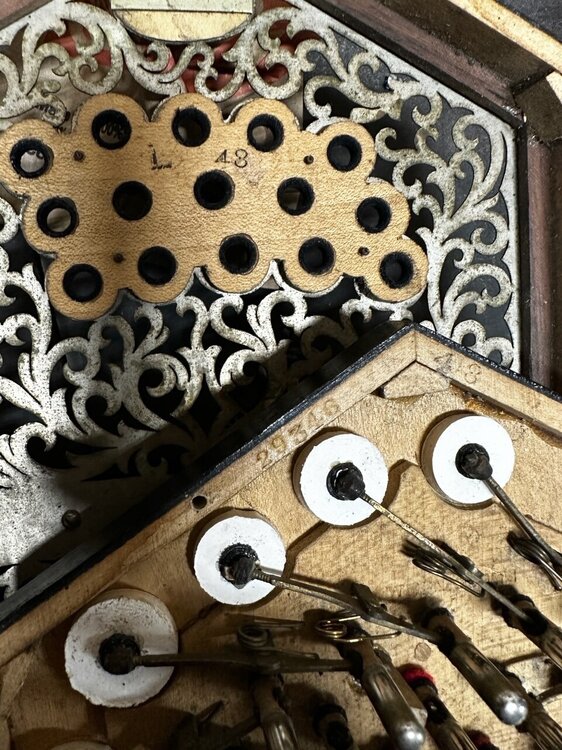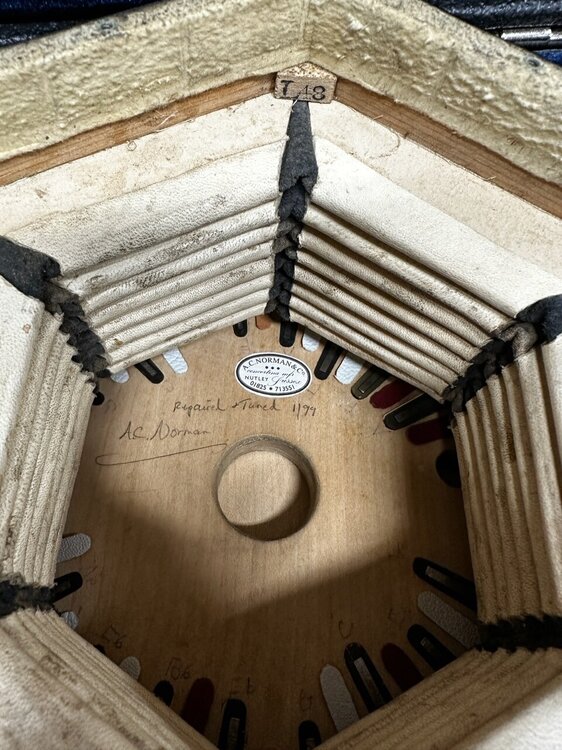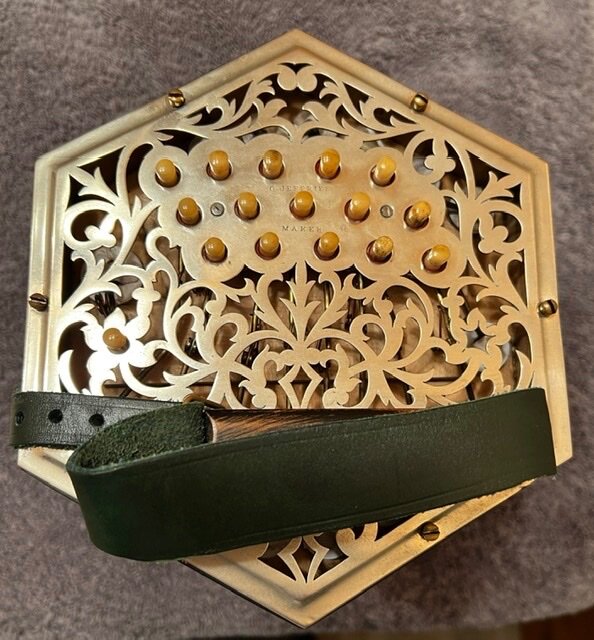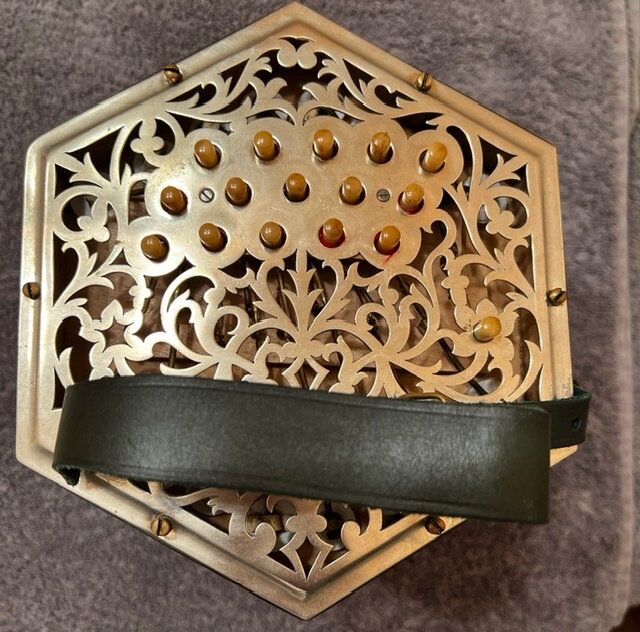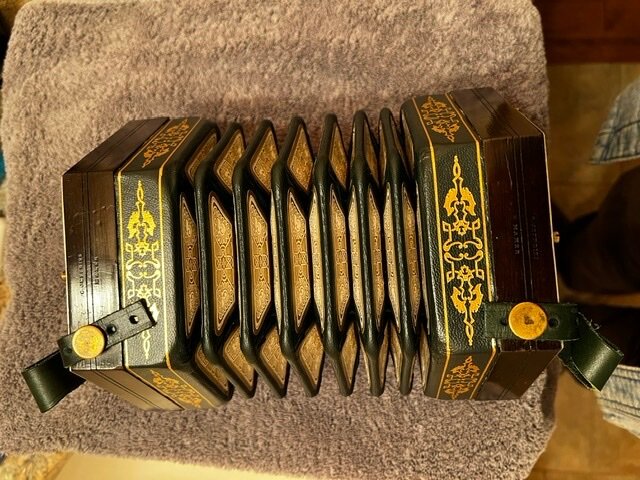
RP3
Members-
Posts
413 -
Joined
-
Last visited
Everything posted by RP3
-
Hi Dana, we haven't spoken in ages, so it is way past time for me to pipe up. It’s been 28 years since we first met and you were already heavily engrossed in the development of another concertina that ultimately led to the Kensington. That’s a long time to maintain such a high level of devotion to our little musical treasure. You’ve truly earned the right to kick back, relax and reflect on how much you have given the concertina community, and while you are at it, play a few tunes. I wish you all the best in what the coming years hold in store for you. You’ve done good! Ross
-
DDF has solved the mystery! I opened up my G/D Wheatstone and looked carefully where DDF recommended, and voila! Like his, my serial number was hard to see, but from just the right angle, it popped into view: 29346. And that number shows up in the first of the two Dickinson Wheatstone ledgers. The ledger listing was dated Sept. 8, 1923: “AGNP 30 keys Special”. I also spotted the “LINOTA’” stamping on the back sides of the palm rests. And again like DDF’s experience, my concertina had been worked on by Andrew Norman. In my case, his work was dated 1/99 and he applied his business sticker. All in all, this was a wonderful period of discovery and I thank DDF for his help in demystifying my concertina. Ross Schlabach
-
Hi Richard, Because the serial number is illegible, I can not refer to the Ledgers and respond authoritatively. Still I believe - like you - that this was a top of the line model. Its construction and more importantly its rich tone and action support that conclusion too. Ross
-
I’m selling an excellent Wheatstone G/D anglo. I acquired this early 1900s anglo from Greg Jowaisas. The serial number has been worn down to the point where it is not legible, and there are no numbers inside to help date this instrument. It has a seven fold bellows in excellent shape with no patches inside or out. I believe the tuning is one of the meantone ones but I don’t know enough about them to be sure. In any case it has a beautiful, rich tone. The layout is Jeffries but the original reeds to put it back to Wheatstone layout and a case are also included. Asking $7,500 OBO. The concertina is in Tryon, NC south of Asheville. Contact Ross Schlabach at rpsqueezer)a-t(gmail.com for more info, additional photos or with questions. Donation to C.net if sold here.
-
In speaking of hex cases, Carroll Concertinas has begun delivering their concertinas in a freshly designed hex case. The workmanship is beautiful. I have one of these cases and previously had a molded hex case. Hex cases can have their drawbacks which include being difficult to keep the case in place when inserting or removing the concertina. Some can “dump” the concertina out if the latch becomes undone while carrying - that is not an issue with the Carroll case which has double latched straps to protect the case from accidental opening. In general, I would say that the small rectangular cases currently made for concertinas are best for handling and stability, but cases like the Carroll one are well cushioned inside, are beautiful supplements for your “kit”, and do an excellent job of protecting the instrument inside - possibly a better job of protection than rectangular cases. Just one man’s opinion. Ross Schlabach
-
Some concerns about the 40-button instrument
RP3 replied to Yuxin Ding's topic in General Concertina Discussion
A couple of things that have been under discussed in this thread: weight and button spacing. Some years ago I ordered a new Ab/Eb concertina from Suttner with 38 buttons with my thinking being similar to others here about chords and the like. I quickly discovered that the instrument was much heavier than my 30 button Jeffries and the button spacing was more cramped. I re-sold it In short order and at the same time regretted my original choice because in hind sight I probably would have been delighted with a Suttner 30 button Ab/Eb. Ross Schlabach -
Lachenal Anglo steel reeded in keys A-E
RP3 replied to d.elliott's topic in General Concertina Discussion
Years ago at one of the Noel Hill US concertina classes, 1996 IIRC, one of our classmates brought a new (to him) 26 button Jeffries Anglo concertina as originally tuned in A/E. While obviously being a bit short on notes, that was one fine sounding instrument. Why it was tuned at that pitch combination no one knows, but when it sounds that good - who cares?! Was great on airs. Ross Schlabach -
On account of advancing age and creeping arthritis I have decided to start thinning my small flock of concertinas. The one I’m selling is a nice 30 bone button C Jeffries that was fully restored (pads, valves, new action boards, tuning and dark green bellows) by Greg Jowaisas. It has a nice action and the sound is a bit more mellow and less barky than some Jeffries. I have another CG Jeffries so this one is one more than I really need. I will be in Raleigh, NC for the next two weeks if you would like to try it out in person - which I highly recommend. After that I will be back in Western NC 45 miles South of Asheville. The asking price is $7,000 (includes a hard case) plus actual shipping and insurance, and payment by PayPal please. Availability limited to lower 48 states. I’ve posted some pictures. If you need more, let me know. Ross Schlabach rpsqueezer*@*gmail.com.
-
Hi Everett, Play it safe and only use Registered Mail from the US Post Office. Everyone who handles the package has to sign for it, so risk of loss is much, much lower than FedEx and UPS. IIRC, there is a limit on the total insurance, but IMHO it is the best way to go if a bit slower. Ross Schlabach
-
Paul I never suggested that you ever implied that my concertina was a Jeffries. I clearly said it was a Crabb but had the additional stampings, etc. that went along with the Crabb history from Geoffrey Crabb’s musings as recounted in the ICA article. And in case there is anybody in doubt, you only ever represented that concertina to me as the Crabb that it was!! And a wonderful Crabb indeed. Jake you hit the nail on the head. Those two accidental row buttons were the culprits - mainly the A/Bb. I also had a 28 button CG Jeffries with an awesome sounding A/Bb to compare to so I knew how they could sound! Ross Schlabach
-
Many years ago I was looking for a better CG Anglo and Paul Groff sold me one he had been playing for some time. It looked very much like a Jeffries (end plates, bellows stamping, bellows papers) but was in fact a Crabb with the oval cartouche left blank. But that was not all. It bore a hand engraved brass plate on the right side frame and the plate read “Rushworth & Draeper, Islington”. AND if you looked very carefully at the wooden side frames, you could see the remains of a stamping “& Co, London”. So this instrument very likely was intended for Ball Beavon & Co. but before it was delivered, the ends were redone and it was ultimately sold by Rushworth & Draeper. This is my conclusion. It was in fact an excellent playing instrument with good tone and nice action. It was let down only by a couple of lower notes that didn’t have the fullness of the rest of the instrument. That concertina helped my playing advance a good bit during my early years with the instrument. Ross Schlabach
-
Concertina found in Brighton UK all the way from California, 1990
RP3 replied to Dino Dini's topic in Concertina History
Olivia, You are misinformed. There is at least one concertina repairman south of Tennessee and he is quite well-known. He is Bob Tedrow at Homewood Musical Instrument Co and he even has his own line of concertina models ranging from Anglo, to English, to Duet. Good man to know! Ross SCHLABACH -
Everett, that rice sounds very reasonable and maybe even a bit low. If it plays beautifully and sounds good, the only thing you might want to do is open it p t check the condition of the wood and the reeds: looking for rust on reeds or brass reeds substituted for steel reeds, and make sure all wood appears sound with no cracks or loose pieces. If available, having an experienced concertina repairman doing that inspection would be best. But, the fact that it sounds and plays well is a good indication of a nice find. Ross SCHLABACH
-
It was very nicely played. And if that box had been on this side of the pond, I’d be wanting to bring it home. Ross Schlabach
- 11 replies
-
- jeffries
- concertina
-
(and 1 more)
Tagged with:
-
Played hammer dulcimer at the time and bought my first Irish CD: Noel Hill. Was smitten. Couldn’t play tunes fast enough on dulcimer, didn’t like tuning every day, and the HD was too heavy to carry around much, SO….. Found an Anglo nearby and I was hooked. Still can’t play fast enough! But I have fun playing with friends. I’d like to play at home more but my Aussie commences howling as soon as I hit the first note! Ross Schlabach
-
TJ, If you go to the Concertina Connection website, it still lists Clover as being sold and the expected delivery time. If interested, you might want to check again. Ross SCHLABACH
-
Ciaran, was one of the stolen Dippers a Shantyman? If so, this could be it. Ross Schlabach
-
Judging from the anchor and cable bellows end stamping, I’m guessing that this is a Shantyman model. It is a shame that there are no end photos or reliable information. Then, since they won’t ship to US, it is a moot point for moi! Ross Schlabach
-
Accordion reed plates falling into block chambers
RP3 replied to Sam O.'s topic in Instrument Construction & Repair
Also try melodeon.net. They focus on accordions. Ross Schlabach -
Kim, I Too have big hands and find Lachenal and Wheatstone concertinas generally too small for my hands. But Crabb, Ball Beavon and Jeffries concertinas work just fine. Surprisingly, the sizes of these three brands is usually about 1/4" smaller across than the Lachenal and Wheatstones, but the button layout on the Crabbs, etc are more open. This is what helps with big hands, not the overall size of the instrument. In fact I am more comfortable playing my Jeffries than a Wheatstone sized concertina. So unless your hands are really much bigger than my "farmers hands", concertina size is not the issue. Now, if you are sure you want lots of extra buttons, then size can be an issue.
-
Alex, you put the green marks in the wrong place. If you look carefully on either side of his second finger, you can see the edges of two buttons which would properly align with the rest of your green marks to create a uniformly spaced outer row. When Jeffries created 28 or 26 button instruments, he left off the top button on each outer row and shifted the remaining buttons toward the upper side (closest to the thumbs). I have a 28 button Bb/F and had a 28 button C/G with that pattern, have friends with 26 button models and I never have seen any <30 button Anglo Jeffries with the uneven button spacing you have suggested. Though I haven’t seen it doesn’t mean it doesn’t exist, but I believe it is highly unlikely. Ross Schlabach
-
While i cannot personally confirm that it was exactly 5” across, there was a small 30 button Jeffries concertina at the 1997 NE Squeeze-In IIRC and that instrument belonged to Noel Hill. That same instrument was featured at the time in Big Nick’s Concertina Guide on the web but the guide is no longer posted. Never heard it play but I can vouch for it’s existence. Ross Schlabach
-
I remember that Mark Bickford had a 26 button A/E that Noel Hill played at our 1996 NHICS class at Bucksteep. He was able to play some wonderful tunes on that old box, and I agree with Larry that this pitch combination was delightful. Ross Schlabach
-
While my session playing days are now over and I was never that good, I can say fairly that “using dots” is not just frowned on in many sessions, but it has the ability to ruin a session. There are several reasons. Unless you only play in a single session with just people who play the tune exactly as your dots represent it, your following the dots can leave you out of step with any changes or variations that arise. And what do you do when they switch to a second or third tune in a set? Do you madly flip pages? Irish music in sessions is, in most instances, fluid while dots are not. Following dots, you aren't able to adapt because you can’t listen, play, and read at the same time. I imagine there are fixed sessions where Dots can find a place, but I would encourage you to develop your ear and learn as many tunes by ear as possible. Sit out for the tunes you don't know or are not yet comfortable with, and cheerfully join in on the tunes that are truly in your fingers. Then you can really sit in and enjoy participating in a session. Ross Schlabach


